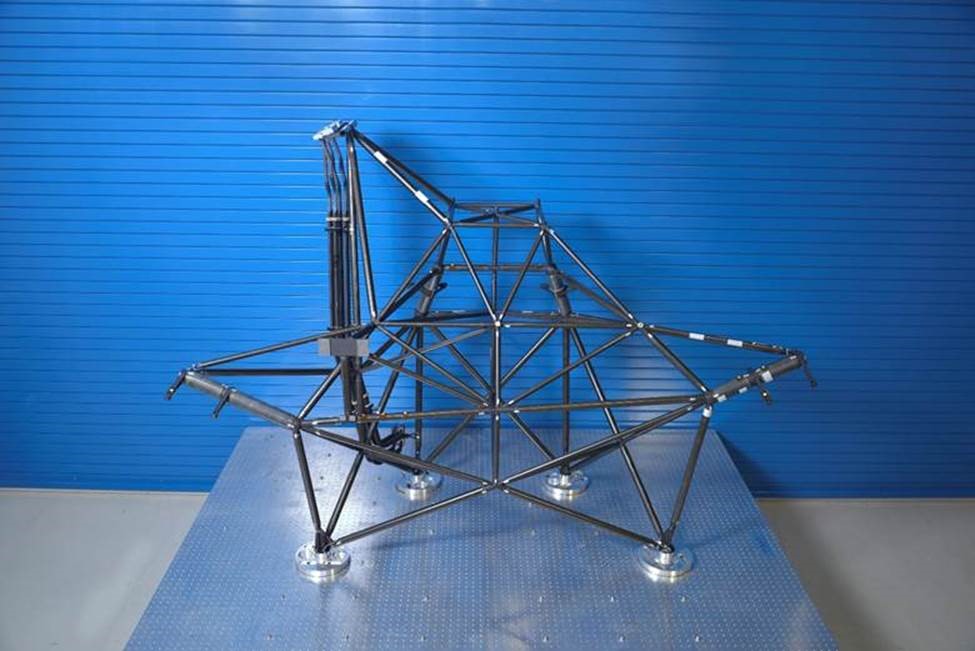SSL DEMONSTRATES INNOVATIVE USE OF ADVANCED TECHNOLOGIES
03/07/2017
Attains roughly 50 percent reductions in mass and schedule for large structures
PALO ALTO, Calif. – March 7, 2017 —Space Systems Loral (SSL), a leading provider of innovative satellites and spacecraft systems, today announced that it has successfully introduced next-generation design and manufacturing techniques for structural components into its popular SSL 1300 geostationary satellite platform. Its first antenna tower designed using these techniques, which include additive manufacturing, more commonly known as 3D printing, was launched last December on the JCSAT-15 satellite, which was designed and built for SKY Perfect JSAT, a world leading satellite operator based in Japan. The satellite, renamed JCSAT-110A, has completed in orbit testing and is performing according to plan.
“SSL is an innovative company that continues to evolve its highly reliable satellite platform with advanced technologies,” said Dr. Matteo Genna, chief technology officer and vice president of Product Strategy and Development at SSL. “Our advanced antenna tower structures enable us to build high performance satellites that would not be possible without tools such as 3D printing.”
The highly optimized strut-truss antenna tower used on JCSAT-110A consisted of 37 printed titanium nodes and more than 80 graphite struts. The strut-truss design methodology is now standard for SSL spacecraft, with 13 additional structures in various stages of design and manufacturing, and has resulted in SSL using hundreds of 3D printed titanium structural components per year.
“We would like to thank our customer, SKY Perfect JSAT for partnering with us on this important satellite manufacturing advance,” said Paul Estey, executive vice president, Engineering and Operations at SSL. “This breakthrough in satellite design is an example of SSL’s holistic approach to new technologies and its teamwork with satellite operators that need to maximize their satellites’ capability.”
For SSL, optimizing at the system level with additive manufacturing has enabled an average of 50 percent reductions in mass and schedule for large and complex structures. The savings over conventionally manufactured structural assemblies is much greater than what is possible with the optimization of an individual part.
Since the launch of JCSAT-110A, SSL has completed assembly and testing on several other strut-truss structures and continues to expand its use of additive manufacturing and other next-generation design and manufacturing techniques.
About SSL
Space Systems Loral (SSL) is a leading provider of commercial satellites with broad expertise to support satellite operators and innovative space related missions. The company designs and manufactures spacecraft for services such as direct-to-home television, video content distribution, broadband internet, mobile communications, and Earth observation. As a Silicon Valley innovator for more than 50 years, SSL’s advanced product line also includes state-of-the-art small satellites, and sophisticated robotics and automation solutions for remote operations. For more information, visit www.sslmda.com.
Forward-Looking Statements
This news release contains forward-looking statements and information, which reflect the current view of Space Systems Loral (SSL) with respect to future events and financial performance. When used in this news release, the words “believes”, “expects”, “plans”, “may”, “will”, “would”, “could”, “should”, “anticipates”, “estimates”, “project”, “intend” or “outlook” or other variations of these words or other similar expressions are intended to identify forward-looking statements and information. Actual results may differ materially from the expectations expressed or implied in the forward-looking statements as a result of known and unknown risks and uncertainties. Known risks and uncertainties include but are not limited to: risks associated with operating satellites and providing satellite services, including satellite construction or launch delays, launch failures, in-orbit failures or impaired satellite performance; risks associated with satellite manufacturing, including competition, cyclicality of SSL’s end-user markets, contractual risks, creditworthiness of customers, performance of suppliers and management of SSL’s factory and personnel; risk associated with financial factors such as volatility in exchange rates, increases in interest rates, restrictions on access to capital, and swings in global financial markets; risks associated with domestic and foreign government regulation, including export controls and economic sanctions; and other risks, including litigation. The foregoing list of important factors is not exhaustive. The information contained in this news release reflects SSL’s beliefs, assumptions, intentions, plans and expectations as of the date of this news release. Except as required by law, SSL disclaims any obligation or undertaking to update or revise the information herein.
# # #
